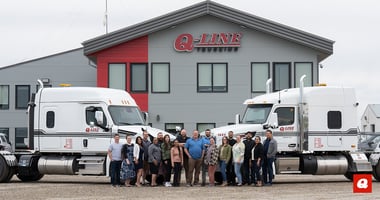Navigating the complex world of freight and logistics can be a daunting task for businesses of all...
What it Costs to Run a Truck
Leading from our last blog post, A Guide to Understanding Your Freight Costs, we will discuss what it actually costs to drive a truck on the road. We will examine five components that fall into two categories related to trucking: Variable Costs and Fixed Costs.
Variable Costs fluctuate based on external factors such as fuel prices, freight rates, and mileage. Fixed Costs remain relatively stable regardless of external influences, such as truck leases, office staff, and administrative expenses.
Variable Costs
1. Fuel
The number one cost for a trucking company is diesel fuel. As the price of diesel increases, so do the costs. Traditionally, semi-trucks average around 6 miles per gallon of diesel fuel, equating to approximately $0.60 per mile for fuel. Since COVID, diesel prices have spiked, resulting in costs rising to as high as $0.90 per mile. This dramatic increase affects freight rates across the board.
2. Driver
The second biggest cost is drivers. They are paid by the mile, with average rates between $0.60 and $0.75 per mile depending on the trailer type and freight complexity. More complex freight leads to higher pay for drivers.
3. Maintenance
Maintenance is the third form of variable costs for trucking companies. The best companies rotate their fleet every 45 years or every 450,000-600,000 miles to reduce maintenance costs. The longer a truck is kept, the more maintenance it will need. Maintenance includes everything from light bulbs to tires to full engine overhauls, covering both the truck and the trailer. Truck maintenance costs range from $0.15 to $0.25 per mile, while trailer maintenance varies between $0.08 and $0.15 per mile.
Fixed Costs
1. Lease and Finance Costs
Most companies cannot pay cash for a truck or trailer, so they finance these costs over 45 years. Pre-COVID, new trucks cost around $150,000, but post-COVID prices have jumped to $250,000 on average. This increase has strained many companies, causing some to defer maintenance to manage expenses. Lease costs for a truck were traditionally $0.30 per mile but have now risen to $0.52 per mile. Companies generally keep trailers for 10 years and finance them over 5 years. Trailer costs vary greatly depending on type: a regular dry van costs about $50,000, while a specialized RGN can reach $200,000. These costs can range from $0.10 to $0.40 per mile.
2. Backend Office and Administration
This encompasses everything not related to driving the truck, including the safety department, accounting, dispatchers, planners, and building and yard space. These costs are relatively fixed and do not fluctuate often. The differences in these costs depend on the company’s robustness. A company with a strong safety department and additional services like merchandise storage, transloading, and cybersecurity will have higher costs, ranging from $0.10 to $0.25 per mile.
All these factors contribute to the overall costs of running a trucking company. The more robust your carrier, the better off your business will be in the long run. In trucking, we say, “It is not about if you have an accident; it is about when you have an accident and how you mitigate the adverse effects for your customer.”
Let’s put all these numbers together:
| Component | Cost Range (per mile) |
| Fuel | $0.60 $0.90 |
| Driver | $0.60 $0.75 |
| Maintenance | $0.23 $0.40 |
| Lease and Financing | $0.40 $0.92 |
| Administration | $0.10 $0.25 |
| Total | $1.93 $3.22 |
When carriers rate freight, they must account for all these costs. If a price is lower than the carrier's costs, they are likely to lose money. Larger, reputable carriers can offset occasional losses with higher-paying freight, but smaller carriers relying on the lowest price will eventually cut corners to reduce costs. Typically, safety and maintenance are the first areas to suffer, considered cost centers without immediate business impact but unsustainable in the long run. Reducing safety or postponing maintenance directly impacts accident rates.
Transportation has historically been a top-heavy industry with small margins. In a good year, the average carrier can expect about a 9% profit, while in a poor year, some are happy to break even. During downturns, a few high-quality carriers will innovate and lead through the crisis, emerging stronger, while others fade away.
Troy Stimpson
Senior Director, Brokerage & Logistics
Troy brings over 25 years of transportation leadership to Q-Line as Senior Director of Logistics. With a deep understanding of transportation operations, he is dedicated to optimizing service delivery and building strong customer relationships. As a visionary, Troy leads his team towards continued excellence in logistics and surpassing industry standards.
Ready to take control of your freight costs?
For your logistics success, understanding freight costs is crucial. At Q-Line, we specialize in delivering transparent and efficient transportation solutions customized to meet your unique requirements. Whether you're shipping standard cargo or oversized loads, our dedicated team ensures your goods arrive securely and within budget
Trust Q-Line to be your strategic partner in mastering freight costs. Contact us today to start optimizing your logistics operations.
Connect With A Specialist



